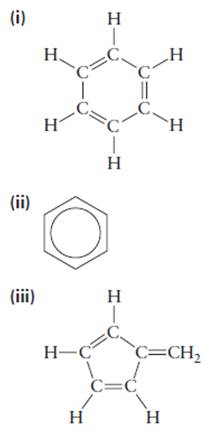
Concept explainers
Consider the following proposed structures for benzene, each of which is consistent with the molecular formula

(iv)
(v)
When benzene reacts with chlorine to give
- only one isomer of that compound forms. Which of the five proposed structures for benzene are consistent with this observation? When
Want to see the full answer?
Check out a sample textbook solution
Chapter 7 Solutions
Student Solutions Manual for Oxtoby/Gillis/Butler's Principles of Modern Chemistry, 8th
- Bunsenite (NiO) crystallizes like common salt (NaCl), with a lattice parameter a = 4.177 Å. A sample of this mineral that has Schottky defects that are not supposed to decrease the volume of the material has a density of 6.67 g/cm3. What percentage of NiO molecules is missing? (Data: atomic weight of Ni: 58.7; atomic weight of O: 16).arrow_forwardA sample of aluminum (face-centered cubic - FCC) has a density of 2.695 mg/m3 and a lattice parameter of 4.04958 Å. Calculate the fraction of vacancies in the structure. (Atomic weight of aluminum: 26.981).arrow_forwardPlease correct answer and don't used hand raitingarrow_forward
- Please correct answer and don't used hand raitingarrow_forwardPlease correct answer and don't used hand raitingarrow_forwardWhich of the following species is a valid resonance structure of A? Use curved arrows to show how A is converted to any valid resonance structure. When a compound is not a valid resonance structurc of A, explain why not. Provide steps and tips on what to look for to understand how to solve and apply to other problems.arrow_forward
- N IZ Check the box under each structure in the table that is an enantiomer of the molecule shown below. If none of them are, check the none of the above box under the table. Molecule 1 Molecule 2 HN Molecule 3 Х HN www. Molecule 4 Molecule 5 Molecule 6 none of the above NH NH Garrow_forwardShow work with explanation. don't give Ai generated solutionarrow_forwardFollow the curved arrows to draw a second resonance structure for each species. Explain and steps for individual understanding.arrow_forward
 Chemistry: The Molecular ScienceChemistryISBN:9781285199047Author:John W. Moore, Conrad L. StanitskiPublisher:Cengage Learning
Chemistry: The Molecular ScienceChemistryISBN:9781285199047Author:John W. Moore, Conrad L. StanitskiPublisher:Cengage Learning Chemistry: Principles and PracticeChemistryISBN:9780534420123Author:Daniel L. Reger, Scott R. Goode, David W. Ball, Edward MercerPublisher:Cengage Learning
Chemistry: Principles and PracticeChemistryISBN:9780534420123Author:Daniel L. Reger, Scott R. Goode, David W. Ball, Edward MercerPublisher:Cengage Learning Chemistry: Principles and ReactionsChemistryISBN:9781305079373Author:William L. Masterton, Cecile N. HurleyPublisher:Cengage Learning
Chemistry: Principles and ReactionsChemistryISBN:9781305079373Author:William L. Masterton, Cecile N. HurleyPublisher:Cengage Learning


